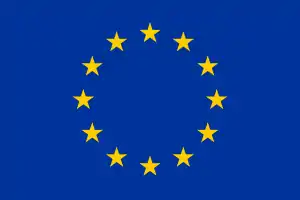Community Plant Variety Office
The Community Plant Variety Office (CPVO) is an agency of the European Union, located in Angers, France. It was established in 1994. Its task is to administer a system of plant variety rights, also known as plant breeders' rights, a form of intellectual property right relating to plants.
 | |
| Formation | 1994 (established) |
|---|---|
| Location | |
President | Martin Ekvad |
| Website | cpvo.europa.eu |
The CPVO manages the largest system of plant variety rights in the World. Since the creation of the CPVO in 1995 the office has received over 61,000, of which it granted over 47,000 applications, with over 25,000 titles currently in force.[1]
Community plant variety right
Plant variety rights allow plant breeders to protect new varieties (or types of plants). The CPVO was created to encourage the creation of new plant varieties in the European Union, through the provision of better intellectual property protection for plant breeders. The Community plant variety right, gives the holder of this right an exclusive right to market the protected variety within the territory of the European Union. The Community PVR is valid for a period of 25 to 30 years.
Breeders' Exemption
The Breeders' Exemption ensures that anyone is allowed to use protected (PVR) varieties as a basis for the creation of new varieties. The Breeders' Exemption exists to ensure that PVR and the need to reward breeders for their work is balanced with the need for new & better varieties to reach & benefit the consumer as quickly as possible. It also ensures the continued production of new varieties as breeders need access to as much genetic resources as possible, including protected varieties, in order to create new varieties.
Application
The CPVO system of PVR protection means that only one application need be made (directly to the CPVO) in order to attain EU wide protection. Before its introduction, EU wide protection was only possible through obtaining national plant variety rights from the individual member states. That option still exists today.
As part of the application procedure, each candidate variety is tested by an examination office. The examination offices are based in the member states, where they are operated by national experts. The examination offices determine whether the variety is distinct, uniform and stable – this is called a DUS test. The CPVO does not own any technical infrastructure.
The results of the DUS tests are used by the CPVO when taking the decision to grant or refuse a PVR application.
Organisation

Based in Angers, France the CPVO was created by the Council Regulation 2100/94 and has been operational since the 27 April 1995.
The CPVO is entirely self-financed. It neither takes from nor contributes to the EU budget. The CPVO's budget is principally derived from PVR application fees paid by breeders who wish to protect their creations.
.jpg.webp)
The President of the CPVO is appointed by the Council of the European Union. The President is responsible for the overall functioning of the CPVO – this includes the implementation of the CPVO's legislative duties and all operational aspects of the CPVO. The current president of the CPVO is Martin Ekvad. Ekvad was appointed to this position in 2011. Prior to his appointment, Ekvad held the position of Head of the Legal Unit of the CPVO from 2003 to 2011.
The CPVO is supervised by the Administrative Council (AC) of the CPVO. The AC is made up of representatives from across the 28 member states, representatives from the European Commission and observer organisations. The AC is also the budgetary authority of the CPVO and adopts the responsibilities annual work programme.
References
- "Statistics". CPVO. Archived from the original on 27 February 2018. Retrieved 26 February 2018.
